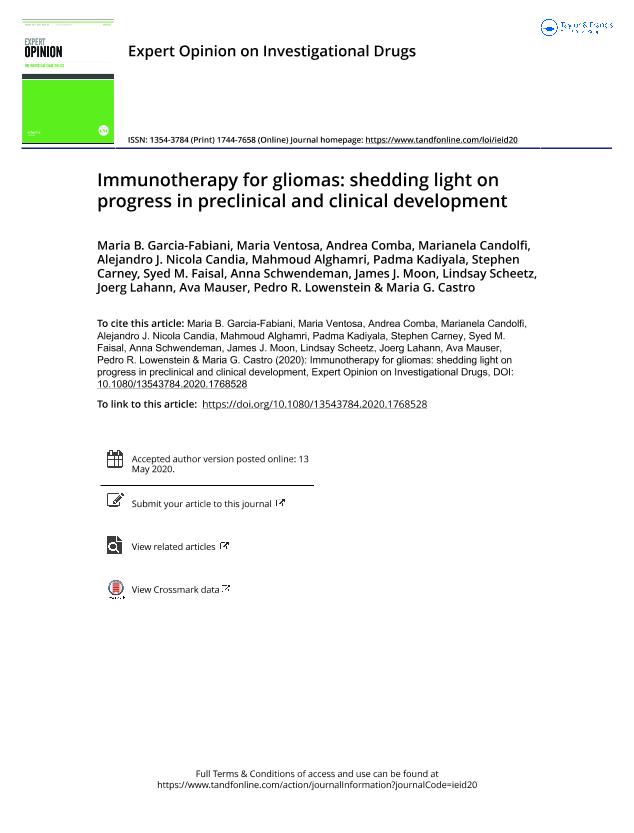Mostrar el registro sencillo del ítem
dc.contributor.author
Garcia Fabiani, Maria Belen

dc.contributor.author
Ventosa, Maria
dc.contributor.author
Comba, Andrea

dc.contributor.author
Candolfi, Marianela

dc.contributor.author
Nicola Candia, Alejandro Javier

dc.contributor.author
Alghamri, Mahmoud S.
dc.contributor.author
Kadiyala, Padma
dc.contributor.author
Carney, Stephen
dc.contributor.author
Faisal, Syed M.
dc.contributor.author
Schwendeman, Anna
dc.contributor.author
Moon, James J.
dc.contributor.author
Scheetz, Lindsay
dc.contributor.author
Lahann, Joerg
dc.contributor.author
Mauser, Ava
dc.contributor.author
Lowenstein, Pedro R.
dc.contributor.author
Castro, Maria Gabriela

dc.date.available
2020-09-07T20:38:39Z
dc.date.issued
2020-06
dc.identifier.citation
Garcia Fabiani, Maria Belen; Ventosa, Maria; Comba, Andrea; Candolfi, Marianela; Nicola Candia, Alejandro Javier; et al.; Immunotherapy for gliomas: shedding light on progress in preclinical and clinical development; Taylor & Francis; Expert Opinion on Investigational Drugs; 4; 6-2020; 1-26
dc.identifier.issn
1354-3784
dc.identifier.uri
http://hdl.handle.net/11336/113423
dc.description.abstract
Gliomas are infiltrating brain tumors associated with high morbidity and mortality. Current standard of care includes radiation, chemotherapy and surgical resection. Today, survival rates for malignant glioma patients remain dismal and unchanged for decades. The glioma microenvironment is highly immunosuppressive and consequently this has motivated the development of immunotherapies for counteracting this condition, enabling the immune cells within the tumor microenvironment to react against this tumor.Areas covered: The authors discuss immunotherapeutic strategies for glioma in phase-I/II clinical trials and illuminate their mechanisms of action, limitations and key challenges. They also examine promising approaches under preclinical development.Expert opinion: In the last decade there has been an expansion in immune-mediated anti-cancer therapies. In the glioma field, sophisticated strategies have been successfully implemented in preclinical models. Unfortunately, clinical trials have not yet yielded consistent results for glioma patients. This could be attributed to our limited understanding of the complex immune cell infiltration and its interaction with the tumor cells, the selected time for treatment, the combination with other therapies and the route of administration of the agent. Applying these modalities to treat malignant glioma is challenging, but many new alternatives are emerging to by-pass these hurdles.
dc.format
application/pdf
dc.language.iso
eng
dc.publisher
Taylor & Francis

dc.rights
info:eu-repo/semantics/embargoedAccess
dc.rights.uri
https://creativecommons.org/licenses/by-nc-sa/2.5/ar/
dc.subject
ANTIBODY
dc.subject
CAR T-CELL
dc.subject
CHECKPOINT INHIBITOR
dc.subject
DENDRITIC CELLS
dc.subject
GLIOMA
dc.subject
IMMUNOSUPPRESSION
dc.subject
IMMUNOTHERAPY
dc.subject
NANOPARTICLES
dc.subject
VACCINES
dc.subject
VIRUS
dc.subject.classification
Otras Ciencias de la Salud

dc.subject.classification
Ciencias de la Salud

dc.subject.classification
CIENCIAS MÉDICAS Y DE LA SALUD

dc.title
Immunotherapy for gliomas: shedding light on progress in preclinical and clinical development
dc.type
info:eu-repo/semantics/article
dc.type
info:ar-repo/semantics/artículo
dc.type
info:eu-repo/semantics/publishedVersion
dc.date.updated
2020-08-19T19:33:47Z
dc.identifier.eissn
1744-7658
dc.journal.volume
4
dc.journal.pagination
1-26
dc.journal.pais
Reino Unido

dc.journal.ciudad
Londres
dc.description.fil
Fil: Garcia Fabiani, Maria Belen. University of Michigan; Estados Unidos. Consejo Nacional de Investigaciones Científicas y Técnicas; Argentina
dc.description.fil
Fil: Ventosa, Maria. University of Michigan; Estados Unidos
dc.description.fil
Fil: Comba, Andrea. University of Michigan; Estados Unidos. Consejo Nacional de Investigaciones Científicas y Técnicas; Argentina
dc.description.fil
Fil: Candolfi, Marianela. Consejo Nacional de Investigaciones Científicas y Técnicas. Oficina de Coordinación Administrativa Houssay. Instituto de Investigaciones Biomédicas. Universidad de Buenos Aires. Facultad de Medicina. Instituto de Investigaciones Biomédicas; Argentina
dc.description.fil
Fil: Nicola Candia, Alejandro Javier. Consejo Nacional de Investigaciones Científicas y Técnicas. Oficina de Coordinación Administrativa Houssay. Instituto de Investigaciones Biomédicas. Universidad de Buenos Aires. Facultad de Medicina. Instituto de Investigaciones Biomédicas; Argentina
dc.description.fil
Fil: Alghamri, Mahmoud S.. University of Michigan; Estados Unidos
dc.description.fil
Fil: Kadiyala, Padma. University of Michigan; Estados Unidos
dc.description.fil
Fil: Carney, Stephen. University of Michigan; Estados Unidos
dc.description.fil
Fil: Faisal, Syed M.. University of Michigan; Estados Unidos
dc.description.fil
Fil: Schwendeman, Anna. University of Michigan; Estados Unidos
dc.description.fil
Fil: Moon, James J.. University of Michigan; Estados Unidos
dc.description.fil
Fil: Scheetz, Lindsay. University of Michigan; Estados Unidos
dc.description.fil
Fil: Lahann, Joerg. University of Michigan; Estados Unidos
dc.description.fil
Fil: Mauser, Ava. University of Michigan; Estados Unidos
dc.description.fil
Fil: Lowenstein, Pedro R.. University of Michigan; Estados Unidos
dc.description.fil
Fil: Castro, Maria Gabriela. University of Michigan; Estados Unidos
dc.journal.title
Expert Opinion on Investigational Drugs

dc.rights.embargoDate
2021-01-01
dc.relation.alternativeid
info:eu-repo/semantics/altIdentifier/url/https://www.tandfonline.com/doi/full/10.1080/13543784.2020.1768528
dc.relation.alternativeid
info:eu-repo/semantics/altIdentifier/doi/http://dx.doi.org/10.1080/13543784.2020.1768528
Archivos asociados
